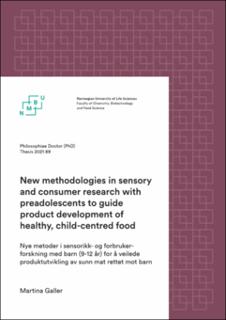| dc.contributor.advisor | Næs, Tormod | |
| dc.contributor.advisor | Arés, Gaston | |
| dc.contributor.advisor | Varela-Tomasco, Paula | |
| dc.contributor.advisor | Liland, Kristian Hovde | |
| dc.contributor.author | Galler, Martina | |
| dc.coverage.spatial | Norway | en_US |
| dc.date.accessioned | 2022-11-29T14:11:05Z | |
| dc.date.available | 2022-11-29T14:11:05Z | |
| dc.date.issued | 2021 | |
| dc.identifier.isbn | 978-82-575-1866-0 | |
| dc.identifier.issn | 1894-6402 | |
| dc.identifier.uri | https://hdl.handle.net/11250/3034795 | |
| dc.description.abstract | Childhood obesity is one of the most serious public health challenges of the twenty-first century (WHO, 2018). In this context, finding ways to make the healthier food choices the preferred ones, can be a valuable contribution to solving this multifaceted problem, as currently the majority of food marketed to children is unhealthy. Sensory and consumer methodologies are needed to support the development of healthy products that children will like and actively chose.
This PhD thesis aimed to establish research-based knowledge on new suitable consumer insight and food testing methodologies with preadolescents. Children in this age group (appr. 9 to 12 years old) are becoming more autonomous, so the study of their self-directed food choices is highly relevant.
Co-creation was explored with preadolescents for the first time in a food context. The potential of co-creation to develop healthier food that children would enjoy and choose was introduced in an opinion paper. Further, a methodological approach applicable to early stages of new product development was proposed for the ideation of healthy food concepts based on case studies in two settings, focus groups and online. Results provided first indications that children could develop concepts for healthy food in co-creation settings. The participative, explorative format was particularly engaging for children.
Two novel indirect methods were studied and compared to traditional questionnaire-based methods: implicit testing and biometrics. The Approach Avoidance Task (AAT) as a particularly easy implicit reaction time task assessed children’s implicit approach biases to different snack pictures. Results indicated a weak correlation of implicit bias to their expected liking ratings. Implicit testing seemed to be more related to concrete situational food preferences due to hunger state. Further, a procedure to facilitate a standardized self-administered tasting by children was established for facial decoding as biometrics measurement. Apart from implicit facial expressions, children were asked to explicitly indicate with their faces how they felt about the tasted sample. Implicit as well as explicit basic emotions correlated with liking ratings, but explicit facial expressions were the most discriminative measurement.
Further, Check-all-that-apply (CATA), an easy method to generate sensory descriptions of food products, was studied with children regarding individual differences in data quality according to ticking style (the way children used the CATA list). Children's approach to the CATA task was studied by defining ticking style indicators: number of ticks, standard deviation of number of ticks per sample, and number of different attributes used in the test. Three groups of children were unveiled. Differences among groups may reflect different cognitive development levels. The findings highlighted, that the CATA method was more suitable for older children of the study (8 to 9 y. o. compared to 6 to 7 y.o.) but that individual differences in cognitive development within age group occurred.
This thesis provides novel methodologies with age-specific recommendations on how to include preadolescents in sensory and consumer studies which can serve the food industry as well as research for better understanding children’s perception of food and food testing procedures. | en_US |
| dc.description.abstract | Ifølge WHO er fedme i barndommen en av de alvorligste folkehelseutfordringene i det tjueførste århundre. I denne sammenhengen kan det å finne måter å gjøre de sunnere matvalgene til de foretrukne, være et verdifullt bidrag til å løse dette mangefasetterte problemet, spesielt tatt i betrakting at mesteparten av maten som markedsføres til barn i dag er usunn. Sensorikk- og forbrukermetoder er nødvendige for å støtte utviklingen av sunne produkter som barn vil like og selv aktivt velge.
Denne doktorgradsavhandlingen hadde som mål å etablere forskningsbasert kunnskap om ny og hensiktsmessig forbrukerinnsikt og metoder for testing av mat med barn (ca. 9 til 12 år). Barn i denne aldersgruppen blir mer selvstendige, så studiet av deres selvstyrte matvalg er svært relevant. | en_US |
| dc.language.iso | eng | en_US |
| dc.publisher | Norwegian University of Life Sciences, Ås | en_US |
| dc.relation.ispartofseries | PhD Thesis;2021:89 | |
| dc.rights | Navngivelse-DelPåSammeVilkår 4.0 Internasjonal | * |
| dc.rights.uri | http://creativecommons.org/licenses/by-sa/4.0/deed.no | * |
| dc.subject | sensory and consumer methodology | en_US |
| dc.subject | children | en_US |
| dc.subject | preadolescents | en_US |
| dc.subject | co-creation | en_US |
| dc.subject | biometrics | en_US |
| dc.subject | implicit | en_US |
| dc.title | New methodologies in sensory and consumer research with preadolescents to guide product development of healthy, child-centred food | en_US |
| dc.title.alternative | Nye metoder i sensorikk- og forbrukerforskning med barn (9-12 år) for å veilede produktutvikling av sunn mat rettet mot barn | en_US |
| dc.type | Doctoral thesis | en_US |
| dc.subject.nsi | VDP::Medisinske Fag: 700::Helsefag: 800::Ernæring: 811 | en_US |
| dc.relation.project | EC/H2020/764985 | en_US |

